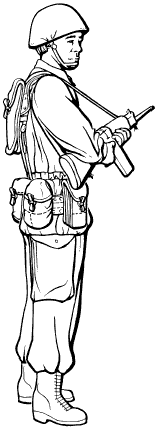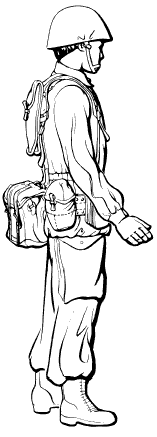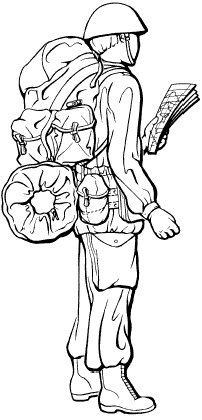xx
Page Under Construction
1982 Pattern Equipment
1982 Pattern Web Equipment was the last major type of web equipment to be issued to the Canadian Army in the 20th Century, and with the advent of the Tactical Vest in the 21st Century, may possibly be the last type of web equipment ever issued to Canadian soldiers.
History
The stated intent of the 1982 Pattern Web Equipment gear was to provide a more flexible and effective system of equipment in response to requests from troops in the field. The new gear was developed using lighter and more durable water repellent fabrics, along with nylon buckles, couplings and quick release features, and was evaluated in extensive user trials.
The 1982 Pattern Webbing, as it was also known, incorporated the design principles of NATO STANAG 2311, and meant to be used in full or partial sets as Fighting Order, Battle Order, or Marching Order. The gear was a modular system, with Fighting Order used as a basic building block (not unlike earlier sets of web equipment) to which the system could be tailored to meet specific mission requirements. To meet this end, the manual also indicates that a "mission analysis of all known users of personal webbing" was conducted, to determine which components would be essential for these missions, and determined the initial issue of these components.
Studies made during the development of the gear were undertaken by Mobile Command, the Defence and Civil Institute of Environmental Medicine (DCIEM), the US Army Natick Laboratories, and the Directorate of Clothing General Engineering and Maintenance (DCGEM). These studies, as well as other studies, were the genesis of several load carrying principles:
Soldiers can carry loads of up to one third their body weight for prolonged periods with little adverse effect
Soldiers can carry loads in excess of one third their body weight, however the effect of so doing is cumulative and directly proportional to the increase in weight and the time carried
Loads should be positioned high on the back and as close to the body as possible
Loads should be carried so as to distribute the weight between the hips and shoulders in the ratio of 60 to 40 percent respectively.
These were the guiding principles for the development of the 1982 Pattern Webbing. The gear was was also designed from the proposition that carrying combat loads would be made more difficult by improper carriage, and that every item had to have a proper place, or in other words, location was important. It was felt the most critical items of equipment should be the easiest to reach.
The load carriage rules that the manual proposed were:
Know the equipment
Assemble the equipment properly
Keep each item in its proper place
Keep the load as light as possible.
In general, the 1982 Pattern Webbing was seen as an improvement over the previous set of load bearing equipment, 1964 Pattern, not least of all because of the provision of ammunition pouches. The padded yoke was also a departure from previous sets. Rather uniquely, a pouch was provided for the issue Knife, Fork and Spoon (always referred to simply as a "KFS") which also had a pouch for the issue C5 Utility knife (or private-purchase Swiss Army knife which was similar in size). The older metal mess tins were also replaced (as the dangers of aluminium poisoning became well known) with a "melmac" plastic plate and cup. The older metal water bottles were replaced with lightweight plastic canteens of US design, with initial patterns being a plain bottle and newer models having an adaptor on the head to enable the water bottle to be used in conjunction with a gas mask.
The rucksack, however, was not popular, despite some improvements over the 1964 rucksack, such as a padded back protector. Chief complaint was the attachment points of the sleeping bag to the bottom of the rucksack, providing a lower centre of gravity; many soldiers continued to use the 1964 rucksack, or at the least the 1964 rucksack frame, and its top-mounted sleeping bag. New soldiers very often privately purchased 1964 pattern rucksacks rather than use the 1982 model.
New developments to the webbing included the replacement of FN C1 magazine pouches with similar pouches of a different size to accommodate the C7 and C8 rifles taken into service in the late 1980s.
Orders of Wear
 |  |  |
| Fighting Order | Battle Order | Marching Order |
Fighting Order
Fighting Order was intended as the basic building block of this equipment. Fighting Order was intended only to provide for a soldier's immediate needs in action. It ensured freedom of movement for the soldier, ease of access and use, and allowed him to carry vital equipment.
Different units developed different standards of what should be carried, but at the minimum, the set provided for the carriage of 4 magazines of rifle ammunition, a plastic water bottle and a utility pouch (in which ammunition, grenades, or more likely the soldier's raingear could be stored), as well as KFS, bayonet, and possibly a gasmask in a separate carrier, slung over the shoulder and worn underneath the webbing.
Note in the illustration at right how the webgear is slung low, over the hips, rather than resting on the hip bones. This was the preferred method of wearing this gear.
This order would not sustain the soldier in action for extended periods of time and would be appropriate for very specific missions of short duration.
Battle Order
Battle Order was similar to Fighting Order, but allowed for the carriage of extra ammunition, equipment, and rations, and conceivably allowed a soldier to carry enough necessities to sustain him in battle for periods of approximately 24 hours. The gear was changed by the addition of a "small field pack" which could be attached to the webbing, or alternately slung over the shoulder. The small field pack was widely referred to as a "butt pack" due to its preferred location directly on the back of the gear, over the buttocks. The melmac plate and cup could be carried in this pouch, along with rations and additional ammunition, though access to this pouch required removal of the web gear. The utility pouch could be utilized for such things as grease pencils, a field message pad in a zippered cloth cover, sticks of face camouflage, earplugs, magazine chargers (though these were often seen tucking into the e-tool attachment points on the yoke), etc.
At least one unit issued out a second small field pack for the carriage of NBC suits.
Marching Order
Marching Order was achieved by the addition of the rucksack, and was intended to get a soldier and enough equipment to sustain him in the field indefinitely from place to place (on foot, if necessary, but also in as compact a manner to enable movement by various types of vehicles.)
The rucksack could carry additional rations, as well as changes of clothing, spare socks, underwear, as well as the soldier's windproof pants, liner for his combat coat (if not worn in the coat), sweater, shave and wash gear (if not carried with his Battle Order), sewing kit, "winter whites", and his sleeping gear (a two part down-filled sleeping bag, flannel liner, and black air mattress, replaced in later years with self-filling green air mattress and augmented with a Gore-Tex "bivvy bag"). A groundsheet was also carried, either to lay underneath the sleeping gear if bivouacked in tents, or to construct make-shift shelters (popularly known as "hoochies").
One major design inconvenience with Marching Order was that unlike, for example, 1937 Web Equipment, the rucksack could not be comfortably worn in conjunction with Battle Order due to the small field pack's attachment to the utility belt. The often seen solution was to take the web gear and attach it externally to the rucksack before donning Marching Order.
The rucksack also had attachment points for large entrenching tools (full size spades and picks), snowshoes, or skis. There was also an internal pouch to accommodate the PRC 77 radio (77 Set)
The 1982 Pattern Equipment was based on three sets:
FIGHTING ORDER, BATTLE ORDER, and MARCHING ORDER.
Basic Components
Belt Utility Small NSN : 8465-21-888-7111
Belt Utility Medium NSN : 8465-21-888-7112
Belt Utility Large NSN : 8465-21-888-7113
Basic Components
Belt Utility Small NSN : 8465-21-888-7111
Belt Utility Medium NSN : 8465-21-888-7112
Belt Utility Large NSN : 8465-21-888-7113
Yoke NSN : 8465-21-888-7105
FN C2 LMG Magazine Pouch NSN : 8465-21-888-7001
Carrier Magazine 9 mm SMG C1 NSN : 8465-21-888-7098 **
WE'82 C7 Rifle Magazine Pouch
C7 Mag Grenade Pouch NSN : 8465-21-910-8502
Cover Water Canteen NSN : 8465-21-888-7093
The first pattern of canteen issued with WE'82 was the same one issued with WE'64.
A new pattern of thermos canteen was issued beginning in the early 1990s.
Carrier KFS - C5 Knife Fork Spoon NSN : 8465-21-888-7114
Holder Scabbard Bayonet (C1) NSN : 8465-21-888-7106
WE'82 C7 Rifle Magazine Pouch
C7 Mag Grenade Pouch NSN : 8465-21-910-8502
Pouch Magazine Utility/200 Round NSN : 8465-21-888-7088
Pouch Mag Utility 200 Round 2 Version NSN : 8465-21-896-8167
Pouch Mag 30 round 5.56 mm 2 Version NSN : 8465-21-896-8166Cover Water Canteen NSN : 8465-21-888-7093
The first pattern of canteen issued with WE'82 was the same one issued with WE'64.
A new pattern of thermos canteen was issued beginning in the early 1990s.
Carrier KFS - C5 Knife Fork Spoon NSN : 8465-21-888-7114
Holder Scabbard Bayonet (C1) NSN : 8465-21-888-7106
Carrier, Scabbard Bayonet (C7) NSN : 8465-21-896-8168
Carrier Combat Shovel NSN : 8465-21-888-7089
1982 Pattern Webbing Equipment
Olive Green

1982 Pattern Web Equipment was the last major type of web equipment to be issued to the Canadian Army in the 20th Century, and with the advent of the Tactical Vest in the 21st Century, may possibly be the last type of web equipment ever issued to Canadian soldiers.
History
The stated intent of the 1982 Pattern Web Equipment gear was to provide a more flexible and effective system of equipment in response to requests from troops in the field. The new gear was developed using lighter and more durable water repellent fabrics, along with nylon buckles, couplings and quick release features, and was evaluated in extensive user trials.

The 1982 Pattern Webbing, as it was also known, incorporated the design principles of NATO STANAG 2311, and meant to be used in full or partial sets as Fighting Order, Battle Order, or Marching Order. The gear was a modular system, with Fighting Order used as a basic building block (not unlike earlier sets of web equipment) to which the system could be tailored to meet specific mission requirements. To meet this end, the manual also indicates that a "mission analysis of all known users of personal webbing" was conducted, to determine which components would be essential for these missions, and determined the initial issue of these components.
--------------------------------------------
Carrier C4 for the NBC Respirator NSN : 4240-21-838-9199
C4 NBC Mask Carrier NSN : 8465-21-907-9546
Pistol Holster 9 mm NSN : 1095-21-889-2573
Pistol Holster 9 mm NSN : 1095-21-889-2573
Field Pack Small (Butt Pack) NSN : 8465-21-888-7096
Set Large Field Pack NSN : 8465-21-888-7107
WE'82 Compass Pouch
WE'82 Pattern AN/PRC 521 Radio Pouch
............................
WE'82 Compass Pouch
WE'82 Pattern AN/PRC 521 Radio Pouch
-------------------------------
1982 Pattern Equipment
P82 webbing
For completeness of the thread the publication you are looking for is called: C-87-248-000/MB-001 - 1982 Pattern Webbing: User's Field Manual.
C7 Mag Grenade Pouch
P82 webbing
Large Pack Assembly Check List
| NSN | Description | Quantity |
| 8465-21-888-7107 | Large Pack Assembly | 1 |
| 8465-21-888-7104 | Back Protector Lower | 1 |
| 8465-21-888-7102 | Harness Shoulder | 1 |
| 8465-21-888-7103 | Shoulder Strap Quick Release | 2 |
| 8465-21-888-7099 | Waist Belt Adjustable | 1 |
| 8465-21-888-7091 | Loop Web - 5 inch | 1 |
| 8465-21-888-7094 | Strap (Mobius Loops) | 1 |
| 8465-21-888-7095 | Strap Sleeping | 2 |
| 8465-21-888-7087 | Field Pack Large | 1 |
| 8465-21-888-7212 | Frame Wire | 1 |
| C-87/248-000/MB-001 | User Field Manual | 1 |
For completeness of the thread the publication you are looking for is called: C-87-248-000/MB-001 - 1982 Pattern Webbing: User's Field Manual.
C7 Mag Grenade Pouch
1982 Pattern Webbing Equipment
Olive Green

1982 Pattern Web Equipment was the last major type of web equipment to be issued to the Canadian Army in the 20th Century, and with the advent of the Tactical Vest in the 21st Century, may possibly be the last type of web equipment ever issued to Canadian soldiers.
History
The stated intent of the 1982 Pattern Web Equipment gear was to provide a more flexible and effective system of equipment in response to requests from troops in the field. The new gear was developed using lighter and more durable water repellent fabrics, along with nylon buckles, couplings and quick release features, and was evaluated in extensive user trials.

The 1982 Pattern Webbing, as it was also known, incorporated the design principles of NATO STANAG 2311, and meant to be used in full or partial sets as Fighting Order, Battle Order, or Marching Order. The gear was a modular system, with Fighting Order used as a basic building block (not unlike earlier sets of web equipment) to which the system could be tailored to meet specific mission requirements. To meet this end, the manual also indicates that a "mission analysis of all known users of personal webbing" was conducted, to determine which components would be essential for these missions, and determined the initial issue of these components.
--------------------------------------------


Your demo picture is fubar'd. The gas mask pouch is located where it makes the mask inaccessible. The mask was worn on its own sling, not on the belt. 82 web gear was a good idea, but had design flaws and was poorly made.
ReplyDeleteThanks for your explicit comment and i will find the autor of that photo so you can write to him too
ReplyDeleteHave a good day Mike
ps try to wear a mask also on your eyes like me